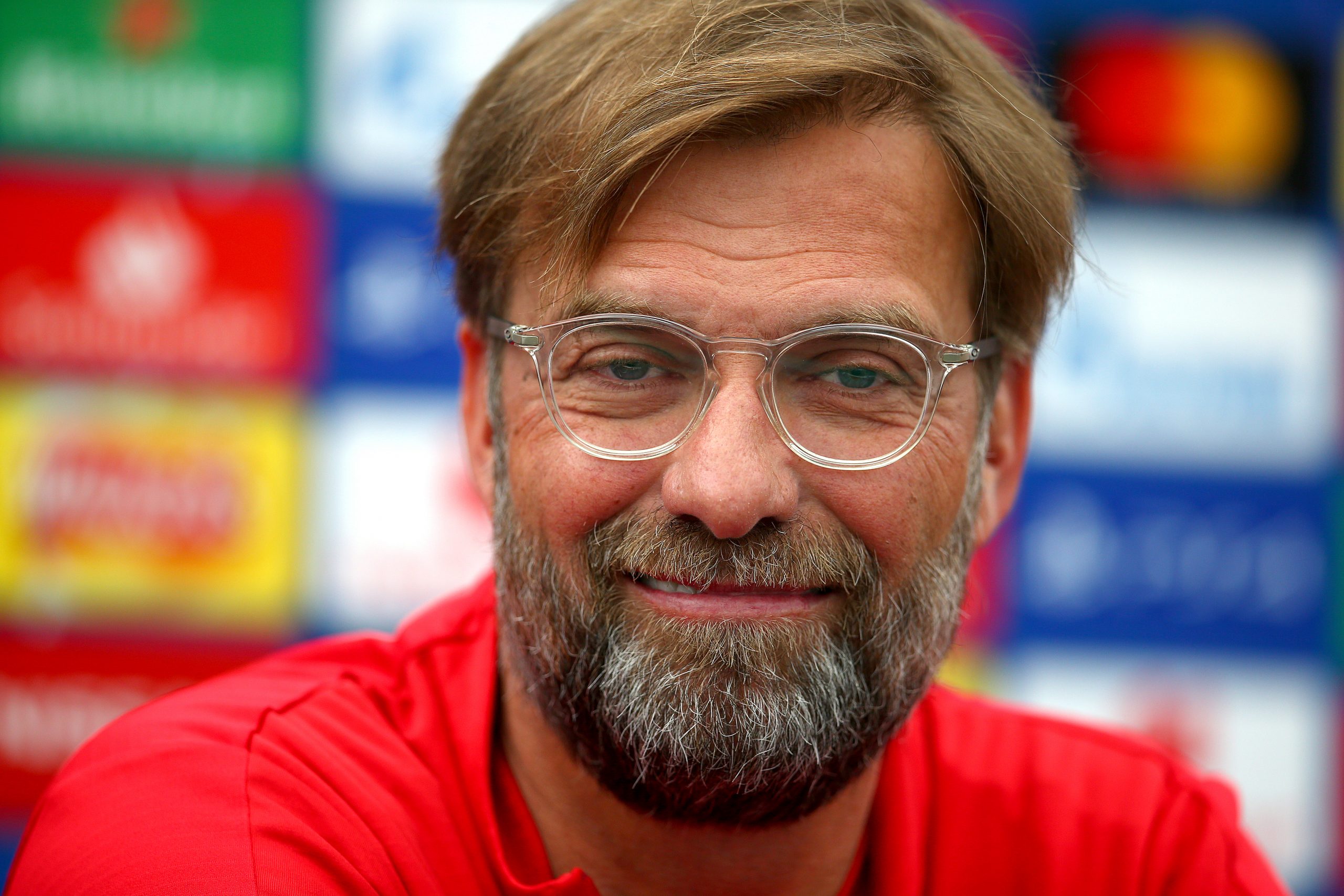How will Jurgen Klopp's approach Saturday's showpiece Champions League final?
The biggest difference for Liverpool between Saturday’s affair in Madrid and last year’s Champions League final defeat in Kyiv is that this time they are the favourites. The 2018 showdown saw them up against a Real Madrid team all set to make it three in a row. This time, not so much. The bookmakers give Liverpool an implied probability of around 65-69% (nice) of lifting the trophy for a sixth time, which instinctively feels about right. Liverpool ended the Premier League campaign 26 points stronger than Tottenham, with most of that disparity coming in the second half of the season. Liverpool start the stronger side, but of course it’s extremely hard to project a likely result onto a one off game like this.
The Road to Madrid
Liverpool made it out of the group stages not on points, not on head to head, not even on goal difference but on superior “goals scored” to Napoli. But for a particularly dreadful performance away at the Stadio San Paolo, the reds played reasonably well in all their group stage fixtures, even running Paris Saint-Germain level on expected goals in the defeat in Paris and falling prey to a particularly unlikely pair of finishes at Red Star Belgrade.
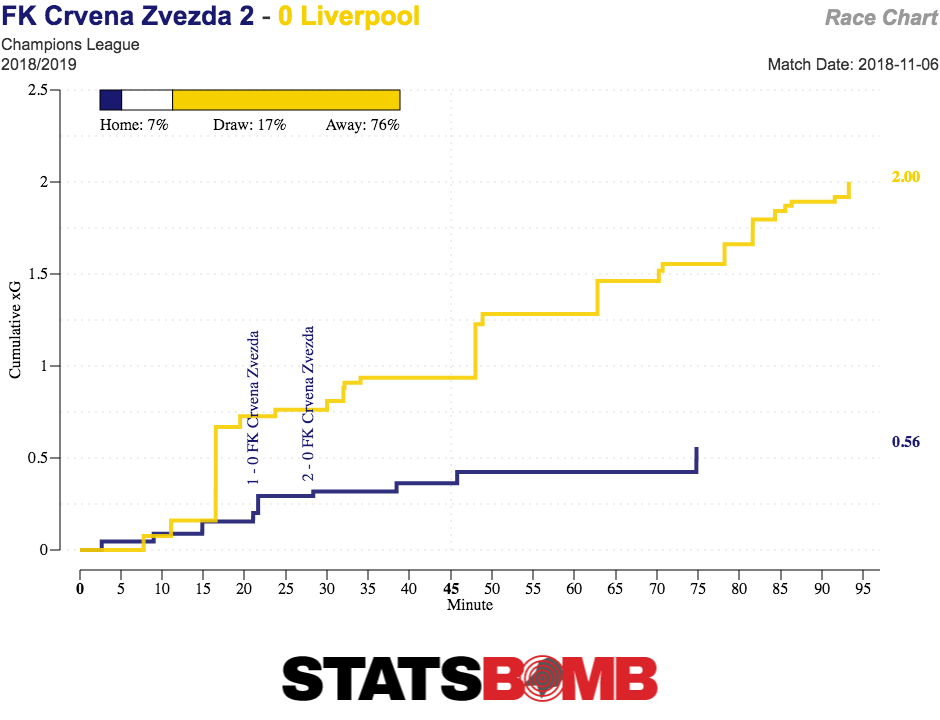
By xG difference, Liverpool actually came out worse than Napoli in Group C, and perhaps the Italians can count themselves a touch unlucky to have fallen at the first hurdle. Granted, we’re dealing with small sample sizes here, and games between three very strong sides and one less dominant team, so it’s difficult to evaluate what the most “fair” outcome would be. But it was the Premier League side who made it through, and if they were not of the sufficient standard, then tougher tests awaited. Though some feel that a declining standard in the Bundesliga has masked some issues at the club, Bayern Munich looked a legitimate hurdle. The first leg, though ending in a 0-0 draw, relieved any concerns, with Liverpool dominating the game and creating plenty of chances that could have seen the home side score. The second leg at the Allianz Arena saw much the same pattern, but with the finishing turning out much better, winning 3-1 both on the night and on aggregate, putting together a very dominant 3.01-0.62 xG performance across both games. 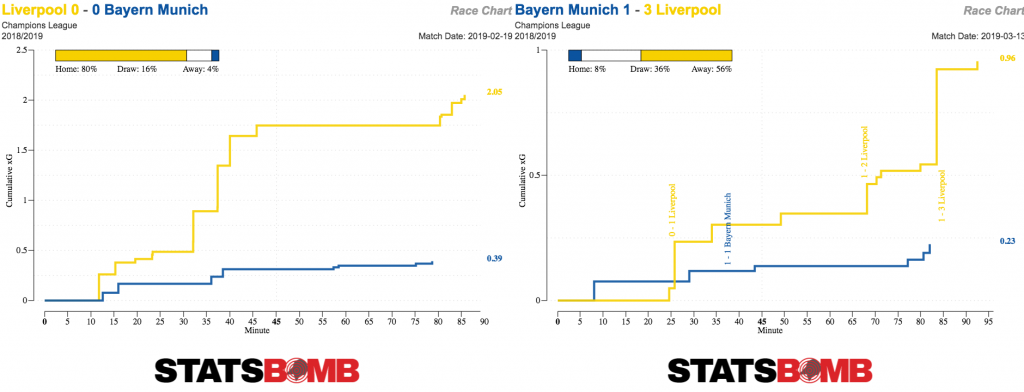 The story against Porto in the quarter-final was generally the same. But for a rocky period in the first half of the second leg, Liverpool were clearly the stronger side throughout and deserved to go through.
The story against Porto in the quarter-final was generally the same. But for a rocky period in the first half of the second leg, Liverpool were clearly the stronger side throughout and deserved to go through. 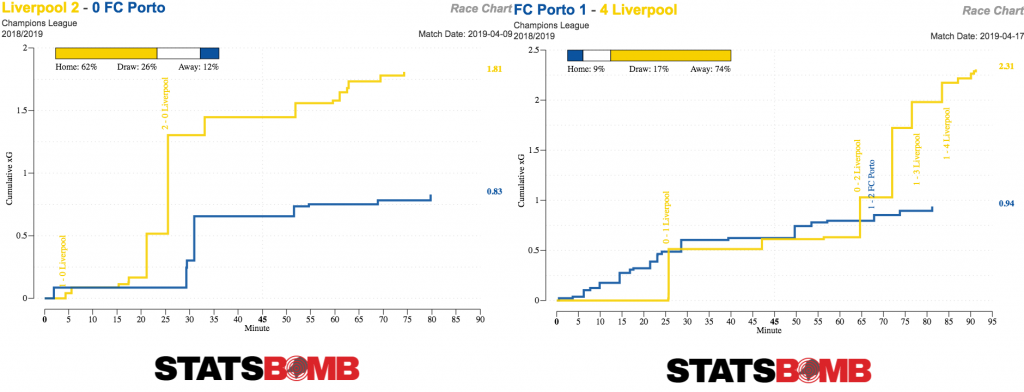
Of course, the comeback against Barcelona is the only match everybody remembers. As much as it deflates the narrative, the story of the tie is that Barcelona were not as impressive as the scoreline suggested in the first leg, nor were Liverpool as strong in the second. At the Camp Nou, Klopp’s side largely functioned effectively in the first two thirds of the pitch, but Gini Wijnaldum’s very poor impression of the absent Roberto Firmino led to Liverpool being unable to link Sadio Mane and Mohamed Salah into the game in the box as they normally do. At the other end, Lionel Messi decided to be Lionel Messi, and sometimes there’s just not a whole lot to be done about that.
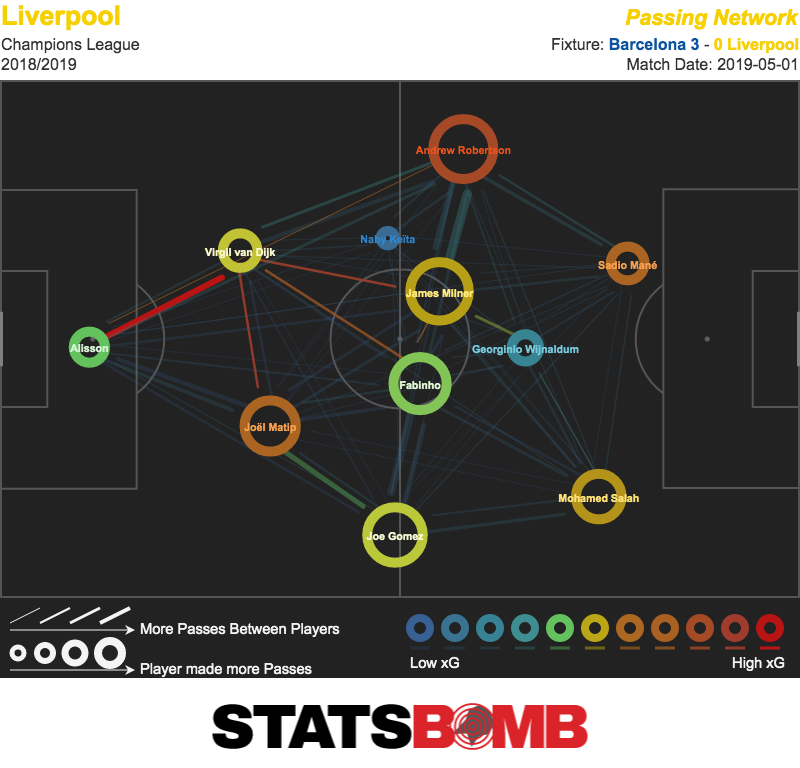
The second leg was similar in many ways in that Liverpool asserted a fair amount of control over things. The goals themselves, though, came from set pieces and moments where Liverpool took advantage of Barcelona errors. The second part has always been part of Klopp’s philosophy, but the most important moments of the game felt almost distinct from Liverpool’s overall plan.
The xG ended up being close enough (3.20-2.63 in Barcelona’s favour) that either side going through was relatively in play. It’s probably difficult for any model to fully quantify something like the Origi goal that sent Liverpool through, in which Barcelona defenders didn’t seem to notice what was happening until the ball went in the net, so the xG figure isn’t the be all and end all. Even if circumstances ended up being rather dramatic, Liverpool managed to do enough.
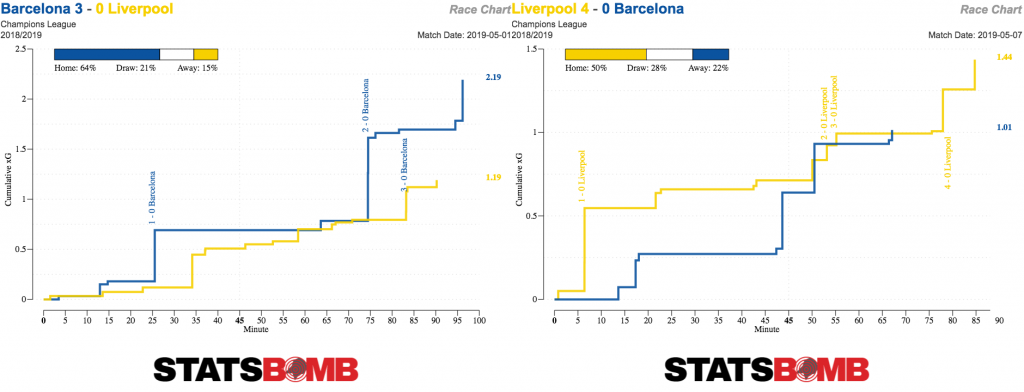
The Shape Liverpool Are In
You couldn’t ask for much more than winning 13 out of the last 14 games in all competitions (and that one defeat was overturned in the famous second leg at Anfield). The Liverpool machine has been running largely consistently for some time now.
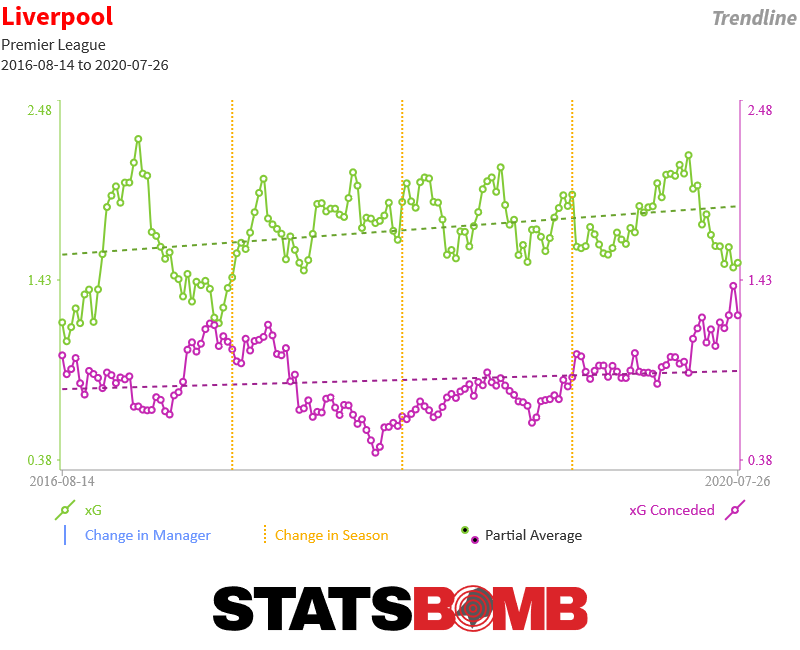
After a period of flirtation this year with a 4-2-3-1 shape, the 4-3-3 that has defined Klopp’s time at Anfield is once again his modus operandi. Much was said in the first half of the season about Liverpool cooling off the press somewhat, but in the Champions League this year it’s looked pretty full on.
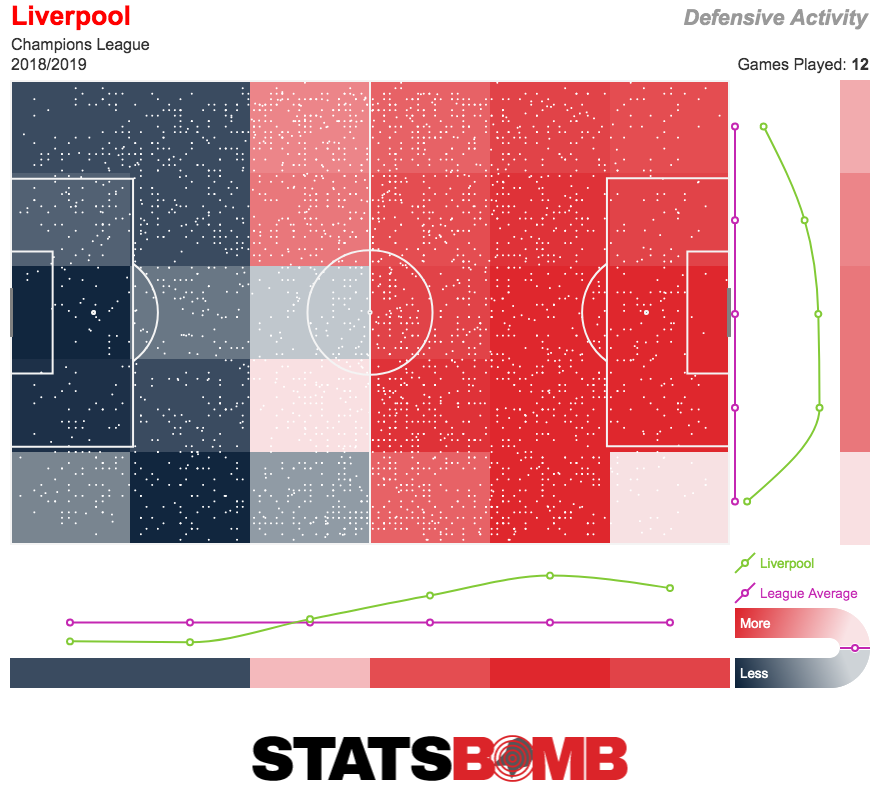
Owing presumably to the tougher fixtures seen in this tournament, Liverpool’s numbers are a touch less impressive and more conservative in the Champions League compared to the Premier League. Liverpool in Europe are not a fun team to play against.
No side that made it as far as the quarter finals aggressively pressed a higher percentage of the opposition’s passes than Liverpool. Their defensive distance, the average position where the side attempt to make a defensive action, is higher up the pitch in Europe than in the Premier League. It’s a more defensive approach in the Champions League, yes, but via high pressing rather than sitting back.
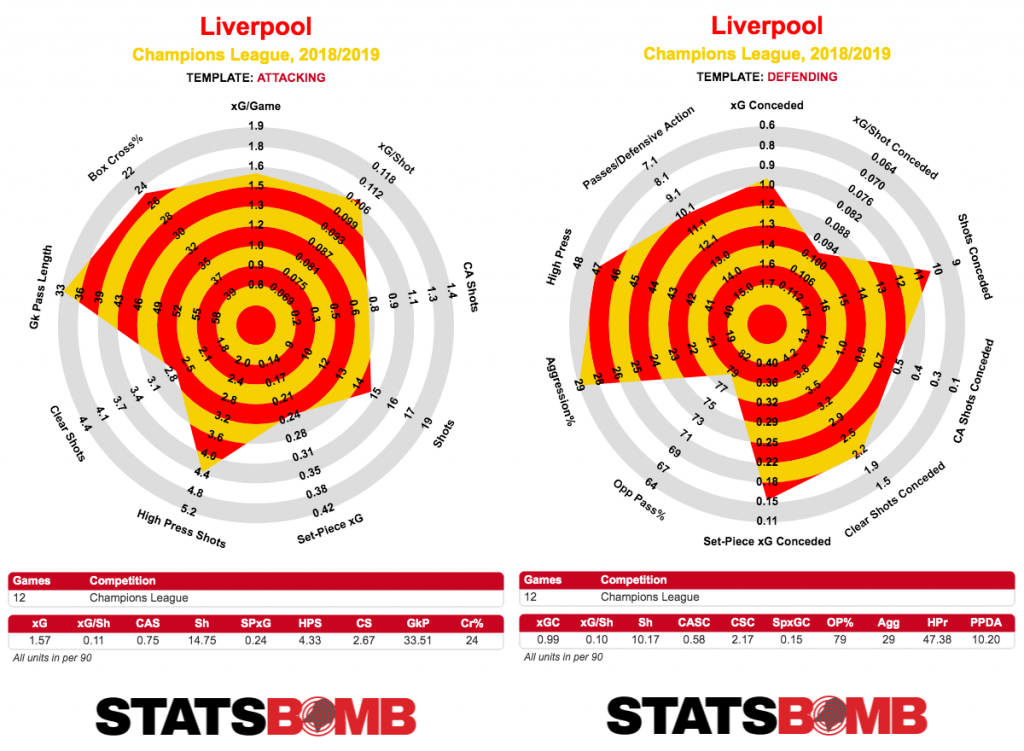
In terms of attacking, in theory Klopp should find it slightly easier in this tournament to create counter-pressing situations. Liverpool’s 53% possession is lower here than the 62% in the league, and the performances against Barcelona and Bayern show a willingness to focus on exploiting opposition errors, more so than in the Premier League where the team inevitably dominate against lesser sides. This might be more of a classically Klopp approach in some ways, focusing on opportunities in transition rather than from possession.
So How Will Liverpool Approach the Final?
The contrast between the two teams’ choices in the run up to Saturday’s game couldn’t be more stark. While Spurs have numerous different system and personnel decisions to make, the Liverpool approach and team largely picks itself. It looks as though Joel Matip has overtaken Dejan Lovren to join Trent Alexander-Arnold, Virgil van Dijk and Andy Robertson in the back four. Naby Keita’s injury makes it very likely that Wijnaldum will join Fabinho and Jordan Henderson in midfield (though there is a chance that James Milner could make a surprise start). If Firmino is fully fit, as it seems he is, he will rejoin Mane and Salah in the attack. Even minor tweaks to this eleven will not change the approach. The team is largely the team. Whether this gives an advantage to one side or the other is anyone’s call.
Liverpool beat Tottenham home and away this season, albeit by fairly narrow margins, with broadly the same approach as usual. Spurs generally look to press Liverpool aggressively, with one notable exception: the 4-1 win over Klopp’s team at Wembley in 2017. Pochettino’s comments in the past have suggested he does not believe that the way to beat Liverpool is to defend deep, so the instinct that they will press high and look to assert dominance on the game, with Liverpool thus continuing the transition-based attacking we’ve seen in the Champions League this season.
Joel Wertheimer has suggested for StatsBomb that Pochettino may employ a very vertical style of play, attempting not to assert control in midfield but to bypass it, and this is something Liverpool will need to be wary of. That it’s so unclear as to how Spurs will set up probably increases the emphasis that Liverpool will place simply on preparing themselves and their plan A, which could be very effective if all goes right. Of course, the margins are fine here, so we should have a thrilling encounter on our hands.
Header image courtesy of the Press Association
